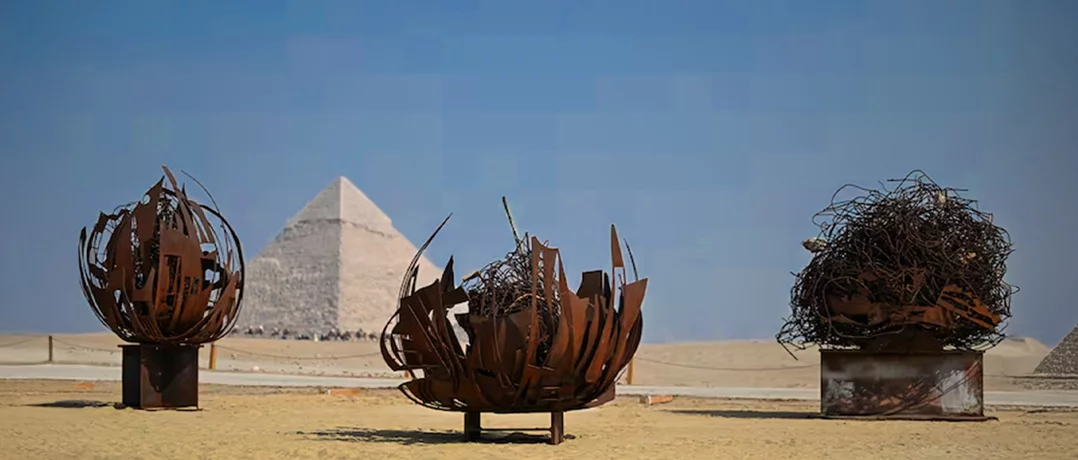Nadim Karam’s “Desert Flowers” turns Lebanese war debris into symbolic lotus sculptures at Giza, expressing resilience and rebirth.
The Lebanese voice at Giza’s ‘Forever Is Now’ exhibition
The Lebanese voice at Giza’s ‘Forever Is Now’ exhibition


At the Pyramids of Giza, the fifth edition of “Forever Is Now” opened this week, an exhibition where contemporary art meets one of humanity’s oldest architectural landscapes. Yet among the global works rising from the desert sand, one of the most eye-catching comes from Lebanon.
Lebanese artist Nadim Karam brought to Giza one of the exhibition’s most politically and emotionally charged installations. Titled “Desert Flowers”, the work appears, at first glance, like three rust-brown lotus blooms emerging from the sand, a nod to the lotus, a symbol of rebirth in Ancient Egypt. But the materials tell a very different story. The towering sculptures are forged from mangled steel salvaged across Beirut and southern Lebanon: twisted metal ripped from buildings, infrastructure, and landscapes struck during Israeli shelling. Some fragments come directly from sites of recent destruction; others are pieces dismantled from Karam’s earlier works in Alula and Beirut.
By using these remnants of violence, Karam transforms debris into growth, destruction into emergence, a symbolic blooming from the ruins. The installation merges devastation with regeneration, recasting Lebanon’s experience of conflict into a universal meditation on resilience.
A Lebanese story on the world stage
“Forever Is Now”, organized by Art D’Egypte in collaboration with the Egyptian government, invites international artists to respond to the cultural and geological weight of the Giza Plateau. This year’s edition, featuring 10 works from around the world, unfolds on the southern side of the site, within full sight of Khufu’s Great Pyramid.
While other installations explore sound, mythology, geometry, and ecology, Karam’s contribution stands out for grounding the exhibition in present-day Middle Eastern realities. Placing Lebanese war remnants at the foot of the pyramids situates modern conflict within a millennia-long continuum of human struggle, endurance, and renewal. The lotus, traditionally a symbol of rebirth, becomes a metaphor for Lebanon itself: a country repeatedly forced to rebuild, re-emerge, and redefine itself from the remnants of destruction.
In a year where global artists used reclaimed stone, urban debris, and conceptual forms to reimagine Egypt’s heritage, Lebanon’s contribution anchors the exhibition in urgency. It reminds visitors that while the pyramids have endured for thousands of years, much of the region is still fighting to preserve, rebuild, and remember. Karam’s Desert Flowers is a testimony. A message from Lebanon placed boldly on one of the world’s most iconic landscapes: that even in environments shaped by ruin, something beautiful can grow.


